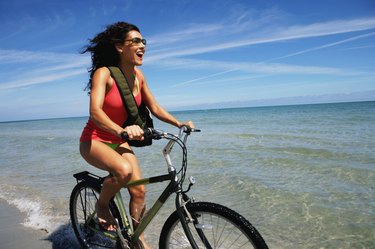
A herniated disk occurs when the soft center of a disk in your spinal column seeps out. A herniated disk may result from poor postural habits or degenerative disk disease because of aging or a decrease in the water content of the disks. A common area of discomfort is L-5, S-1, or the fifth vertebra of the lumbar where it meets the first vertebra of the sacrum. Riding a bike may be possible depending on the severity of your injury and pain level. Do some therapeutic exercises before biking to build strength in surrounding muscles.
Learn Good Postural Habits
Video of the Day
Several yoga exercises can help reduce pain and help improve posture to prevent further injury. Standing in tadasana, or mountain pose, can quickly identify any spinal imbalances. Lordosis occurs when you arch your low back excessively. Find tadasana by standing with feet hip-width apart with your knees slightly bent. Place your hands on your hips and tilt your pelvis forward into lordosis. Next, tuck your tailbone under into a posterior pelvic tilt. Return to a healthy neutral stance by lifting your frontal hip points and actively pressing your heels down while contracting the quads and hamstrings. Tadasana reinforces a tall posture to reduce compression in L-5/S-1. If you can maintain this healthy pelvic orientation while biking, you may find it is not painful.
Video of the Day
Therapeutic Yoga Poses
Use a therapeutic version of a basic yoga pose, setubhandasana, or bridge, to create space in the lumbar and sacrum. Lie on your back, setting your feet flat hip-width apart, knees bent. Press into your feet and lift your hip and bringing your arms alongside you, press the palms into the floor. Remain for a few breaths. Lower your body. Next set a light foam yoga block between the inner thighs and return to bridge pose, elongate through crown of the head and the tailbone, and squeeze the outer hips, gluteus medius. Avoid gripping the back of the hips, the much larger gluteus maximus — which may create more pain in the lumbar. Remain for a few breaths and rest. Apply this to when you sit on a bike seat: without gripping the seat, extend through the top of the head and avoid tucking the tailbone. Again, any pain or discomfort is your barometer as to whether biking is appropriate.
Rehabilitative Resistance Training
Include resistance training to help strengthen the legs and hip flexors to give you stability for walking and biking. Use the seated double hip adductor machine and the seated double hip abductor machine. Do three sets of eight reps of very low weight. By doing this, you work the inner thighs, or adductors, and the outer hips, gluteus medius. Both contribute to stability in the sacrum for a steady gait walking and ease sitting on a bike seat.
Create Stability in the Sacrum
Use standing leg press as a way to create muscle strength in the quads of the front of the thighs and gluteus maximus as well as moving both hip joints in a healthy range of motion. Select a light weight or no weight, and do three sets of eight reps. The idea is to combine postural awareness, therapeutic yoga poses and therapeutic exercises to help reduce pain and keep you mobile.
Is this an emergency? If you are experiencing serious medical symptoms, please see the National Library of Medicine’s list of signs you need emergency medical attention or call 911.